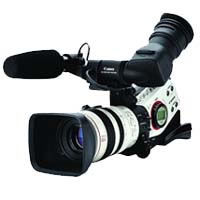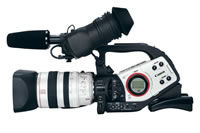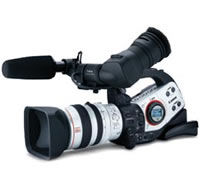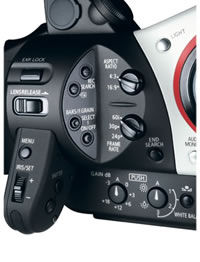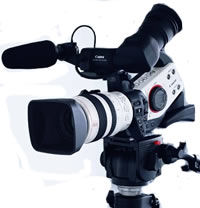- Rental ID: R302171-C
Included in Rental
- 1 Canon XL2 Digital Camcorder Body
- 1 Canon 20X XL 5.4-108mm L IS Video
- 1 Frezzi MRFIC-4X Dimmer Micro-Fill
- 1 Canon BP-950G Battery Pack
- 1 Ultralink Matrix-2 IEEE 1394 4-Pin to 4
- 1 Ultralink Matrix-2 IEEE 1394 4-Pin to 6
- 1 Noga MG11043 Articulating Arm -
- 1 Cool-Lux L-14 12V Batt.Belt W/1 Cig.&
- 1 Cool-Lux 1.2 Amp Fast Chrger/L-7
- 1 Manfrotto 181 Folding Auto Dolly
- 1 Manfrotto 165MV Tripod Spreader for
- 1 Canon BP-930 Battery Pack
- 1 Manfrotto 501 Pro Video Head
- 1 Canon CA-910 Compact AC Adapter
- 1 Canon BP-945 Battery Pack
- 1 Nebtek 7"" Monitor w/Connector - Canon
- 1 Canon CA-920 Compact Power Adapter
- 1 Manfrotto 482 Micro Ball Head
- 1 Manfrotto 482LCD Micro Ball Head
- 1 Lenmar NoMEM Li-Ion CANON BP-941
- 1 Manfrotto 525MVB Lightweight Video
- 1 Manfrotto 523PRO Lanc Remote Control Pro
- 1 Frezzi MRFA Micro-Fill Combo 2 barn
- 1 Frezzi LS-21A Mounting Stud
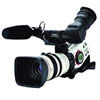
Canon XL2 Event Kit
$840.00/week Add to Request
Overview
An Open Architecture philosophy, performance found only in much more expensive video cameras, Total Image Control and the solid foundation of Genuine Canon Optics, interchangeable lens capability and superb Canon image processing quality are united in the XL2.
The XL2 brings a host of performance and convenience features to this class of video camcorder- benefits that can't be found in this combination on other high-end video cameras. They include: Canon Super Range Optical Image Stabilization in the standard lens; dual aspect ratios; various frame rate capabilities; image gamma and detail controls; skin detail control and convertible LCD display and among others.
Unprecedented image control coordination between two XL2 cameras, remote computer camera control and direct video recording to computer are just a part of the capabilities of the XL2. Never before has so much creative power been put in the hands of the film maker, video artist, and corporate and event videographer.
16:9 and 4:3 aspect ratio shooting formats
With an increasing consumer shift towards widescreen TVs that deliver the full width of film-based theatrical movies, plus the resulting need for productions in the 16:9 aspect ratio, Canon's XL2 offers both the standard 4:3 aspect ratio and the 16:9 widescreen TV aspect ratio. Representing the ratio of the screen width to its height, the 4:3 aspect ratio is that of the common TV screen, and is the most commonly used aspect ratio in broadcasting today.
The 16:9 aspect ratio is the more common aspect ratio for film-based movies, and produces full screen playback on widescreen TVs. 16:9 also is the world standard aspect ratio for HDTV.
By offering a camcorder that is able to be switched between the two aspect ratios, Canon opens the door for multiple production options with the same camera -- the XL2.
Variable frame rates
60i / 30p / 24p (2:3 and 2:3:3:2 both with 1/48th second shutter speed) frame rates are available in the XL2.
The demands being made on the video production community to be able to provide solutions under a multitude of different scenarios have been met with the Canon XL2. It delivers 60i, 30p, 24p (2:3 and 2:3:3:2) frame rates. 60i (interlaced) is the standard video frame rate that has been in use for decades; it's what you see on your home TV, and is captured by handheld consumer camcorders. Progressive (non-interlaced) scanning mimics a film camera's frame-by-frame image capture. 30p, or 30-frame progressive, a non-interlaced format, produces video at the rate of 30 frames per second, delivering spectacular clarity for high speed subjects. Shooting in 30P mode offers video with no interlace artifacts.
The 24p frame rate, for example, is now widely adopted by those planning on transferring the video signal to film. But film/videomakers turn to 24p for the "cine" look even if their productions are not going to be transferred to film, simply because of the "look" of the frame rate. Also just as important as 24p, is the shutter speed of 1/48th per second. This is the standard shutter speed that movie cameras use. The combination of 24p frame rate and 1/48th perfectly mimic a motion film camera.
24p with 2:3 pulldown produces video with the look and motion of film. (24p, used in conjunction with a cine gamma curve on the XL2, produces images that have similar tonal characteristics as film. This mode is used when the finished video will be shown on television. 24p with 2:3:3:2 pulldown, is used when the video is going to be transferred to film. The 2:3:3:2 pulldown allows to editing software to extract true 24 frames a second.
Customizable Cine Look
With "big name" and not so well known producers turning to digital video for their "films," increasing emphasis has been placed on delivering the cine look to video. The Canon XL2 offers its users the ability to customize their video recordings using a number of variables: color matrix, gamma, knee, black stretch, vertical detail, coring, sharpness, noise reduction, color gain, hue, and film grain. Each one of these can be adjusted independently, thereby giving you precise control over the "film-like" appearance of your video.
Total Image Control
Professional videographers need to have control over the set-up of their camcorder. From complete automatic setting to fine adjustments of Master RGB, Setup Level, Master Pedestal, Skin Tone Detail, Program AE, Gain, AE Shift and Lock, White Balance, Shutter Speeds, Aperture Control, Zebra Patterns Clear Scan and Interval Timer the XL2 has the total image control that professionals need.
XL Mount Interchangeable Lens System
A key feature of the Canon XL-series camcorders (and the only MiniDV format camcorders with this feature), is the XL mount interchangeable lens system. Unlike other systems, the XL2 offers users the ability to change lenses, whether from within the XL series of video lenses, third-party cine lenses, or Canon's extensive range of photo lenses. This not only makes the XL2 a far more versatile camera, it also opens up incredible opportunities for the XL2 user.
Within the Canon XL system alone there are four lenses: the new 20x OIS, 16x OIS, 16x Manual, and 3x Wide. Then, using an XL system adapter, the entire range of Canon photo lenses is available -- a tremendous boon to those producing wildlife and nature documentaries, for example. Other companies also offer a variety of specialty cine lenses that can be used on the XL2.
Flourite Zoom Lens with Optical Image Stabilization
Canon is known worldwide for its optics -- its broadcast and photo lenses, for example. The new 20x Professional L-Series Fluorite optical zoom lens for the XL2 is an outstanding lens, using fluorite to deliver outstanding resolution, contrast and color reproduction. In addition, the lens features Canon's superb optical stabilization system. This corrects camera shake instantly and, with its SuperRange feedback system, even catches low-frequency vibrations, refining the movement of the vari-angle prism, delivering the most advanced optical image stabilization available today.
SMPTE time code
The Canon XL2 offers many on-camera enhancements to help capture high-quality footage, including features commonly found on broadcast camcorders. Among these is the placement of a SMPTE time code on the tape. SMPTE (Society of Motion Picture and Television Engineers) time code is a digital signal that assigns a number to every frame of video, representing hours, minutes, seconds, frames, plus some additional information. The SMPTE time code is used to identify a precise location on a video tape, a mainstay of professional editing allowing all tape and equipment to work together for precise editing.
You can choose Drop, Non-Drop, Rec Run and Free Run modes. Also provided is User bit settings, allowing the inclusion of reel number or other user data.
The XL2 also generates SMPTE color bars with 1 KHz tone (-12dB and -20dB). SMPTE color bars with tone are the standard method of setting up video and audio monitors and edit suites. By using industry standard color bars and tone, the XL2 fits in with all production equipment.
Custom Presets
Three custom presets are provided on the XL2, and each can be assigned any one of a number of functions, accessible at the touch of a button, for faster and easier camera operation. Among the functions are: color gain, color phase, sharpness, setup level, V detail, color matrix, gamma, knee, black stretch, skin detail (hue, gain, area, Y level).
These custom presets can be transferred to another XL2, or to a computer (3rd party software required), using the IEEE1394 connection.
20x Optical zoom
Canon's 20x Professional L-Series Fluorite lens for the XL2 is the equivalent, in 35mm format, of a 42.3 - 846mm lens when the camera is recording in 16:9 widescreen format. When the 20x Professional L-Series Fluorite lens for the XL2 is recording video in the TV-standard 4:3 aspect ratio, it is the equivalent, in 35mm format, of a 51.8 - 1036mm lens.
Super Range OIS (VAP type)
Canon's superb optical stabilization system corrects camera shake instantly so even hand held shots, at full telephoto, and shots taken from a moving car, are smooth and steady. And since it is optical, there is no loss of image quality inevitable with electronic image stabilizers. It perfectly complements the high picture quality of the DV format.
Previously, optical image stabilizers have used a gyro sensor to detect camcorder vibration (the data from which controls a vari-angle prism that continuously corrects the path of the incoming light). SuperRange goes one step further by examining the image after it is received by the CCD, and detecting any low-frequency vibrations missed by the gyro. This data is fed back to accelerate and refine the movement of the vari-angle prism. This greatly improves performance for low frequency vibration, resulting in the most advanced optical image stabilization available today.
f/1.6 - f/3.5
Canon's 20x Professional L-Series Fluorite lens features a fast aperture of f/1.6, variable to f/3.5 at full telephoto. This maximum aperture of f/1.6 aids in capturing quality video in low light conditions.
72mm filter thread
With a standard 72mm filter thread, the 20x Professional L-Series Fluorite lens offers the availability of a wide variety of filters from Canon and other suppliers.
Fluorite 'L' series lens
Canon has satisfied the demands of experienced image makers for years through the power, design and quality of 35mm and broadcast TV lenses. Canon's Professional L-Series lenses utilize fluorite, a material that provides outstanding resolution, contrast, and color reproduction - especially in lightweight, high-magnification lenses. Incorporated into the XL2's 20x lens, fluorite delivers the ultimate in clarity and image quality. The fluorite element inside the lens defeats color aberration (an effect that causes a reduction in sharpness, contrast and color). The fluorite lens precisely controls components of light providing an excellent balance of these three critical ingredients of picture quality. This is unobtainable with conventional optical glass.
-6 blade iris diaphragm
A six-blade circular iris is used in the XL2 for professional exposure control. This helps to deliver stunning video and still photos.
-2 independent ND filters
The 20x Professional L-Series Fluorite optical zoom lens includes two neutral density filters to help control light -- for example under bright, sunlit conditions, or when less depth of field is desired. The two built-in filters, 1/6 ND and 1/32 ND, can be used independently.
-Electronic focus and zoom ring
The focus ring and the zoom ring are independent controls on the 20x lens. They are servo controlled and the speed can be changed by the speed of the rotation of the ring. There is also a zoom control on the handgrip and one on the top handle.
-Zoom preset position
This function allows memorization of a zoom point, so that the lens can return to that framing by a push of the button. The speed of the zoom can easily be controlled.
-Focus preset position
This function allows memorization of a focus point, so that the lens can return to that focus by a push of the button. A 'pull focus' can easily be accomplished. The speed of the focus can easily be controlled.
CCD's Aspect Ratios and Shooting Modes
- 3 CCDs, 1/3 inch, gross 680K (each) progressive scan, horizontal pixel shift
- 16:9: 960x480 effective pixels (460,800 pixels per CCD, total 1,382,400)
- 4:3: 720x480 effective pixels (345,600 pixels per CCD, total 1,036,800)
Building on the superior image quality associated with its industry-leading XL1 and XL1S camcorders, Canon has made a major step forward with the XL2. The XL2 continues to feature a three CCD (charge-coupled device) system with a separate CCD for each primary color (red, green, blue). But the system now features even higher resolution, delivering outstanding picture quality, highly accurate color reproduction and a wide dynamic range with virtually no color noise. The three CCD image sensors are specifically designed to capture as much image detail as possible and for shooting under extremely low light conditions. In super low light, the XL2 captures crisp and clear digital data. Under extremely bright conditions, the XL2 greatly reduces vertical white streaks and smears, making it a consummate field recording device for all conditions.
With the XL2, a beam-splitting prism separates light passing through the lens into individual color components and each is sent to its own CCD. Compared to a single CCD, the three CCD system achieves outstanding detail with highly accurate color reproduction suitable for the demands of high-end video production: wide dynamic range, low color noise, high-contrast detail, natural color resolution and low-aliasing.
- 16:9 and 4:3 shooting formats
In the XL2, Canon offers both the standard 4:3 aspect ratio and the 16:9 widescreen TV aspect ratio (the ratio of the screen width to its height). The 4:3 aspect ratio is that of the common TV screen, and is the most frequently used aspect ratio in broadcasting today. The 16:9 aspect ratio is the more common aspect ratio for film-based movies, and produces full screen playback on widescreen TVs. This aspect ratio is menu selectable on the XL2.
- 60i, 30p and 24p (NTSC format)
The XL2 delivers 60i, 30p and 24p frame rates. 60i is the standard video frame rate used in television today, as viewed on your home TV, whether from a broadcast signal, rented DVD or home camcorder. 30p, or 30-frame progressive, is a non interlaced format, the same as Canon's Frame Movie Mode, producing video at 30 frames per second, delivering spectacular clarity and a cinematic-like appearance. 24p, also non-interlaced, produces video with the look and motion of film; its capture rate is the same as that of movie film for theatrical viewing.
- 24p - both 2:3 and 2:3:3:2 with 1/48th second shutter speed
Both variations of the 24p frame rate -- 24p, 2:3 and 24p, 2:3:3:2 -- are supported by the XL2. The 2:3 pulldown is the conversion method to convert 24p to 60i so that video shot in either 24p frame rates can be viewed on a television. The 2:3:3:2 pull down is used when the footage is to be transferred to movie film.
Customizable Cine Look
-Gamma (Video/Cine)
Gamma controls the general brightness (luminance) of the picture and the contrast of the picture. Adjusting gamma allows you to control the way the camera reproduces various tones. Video shot on the XL2 can be gamma corrected to allow for the final usage of the video -- where it will be shown. The display medium can distort the brightness, therefore if the gamma is corrected for the display medium when the video is shot, the display will show the correct brightness level. By switching to the Cine curve, the tonal qualities of the images produced have shading and coloration similar to that of film.
-Color Matrix (Video/Cine)
The XL2's Color Matrix function manages the hue and saturation of the video to reproduce the most accurate color. The color matrix defines the camera's color output; the matrix lets you define the amount of primary and secondary colors that are produced. The primary colors are red, green and blue, with the secondary colors (cyan, magenta, yellow) made from the combinations of two primary colors. With the XL2's Color Matrix, you can change from a video to a cine "look" for the end product.
-Knee (H/M/L)
Among the XL2's picture-enhancing circuits is the knee circuit. Setting the control to high, medium or low manages the highlight compression of the video signal.
-Black (Stretch/Normal/Press)
The XL2 gives the user control of the depth of black in dark areas of an image. To emphasize contrast in the video's dark areas, "Stretch" is selected. To deepen or enhance the dark area, "Press" (compress) is selected.
-Vertical Detail (Normal/Low)
There are 2 settings: "Normal" for vertical detail optimized for playback on an interlaced monitor, "Low" for vertical detail optimized for a progressive scan monitor like a PC.
-Coring (-6 to +6)
The Coring function on the XL2 is useful in helping to remove image "noise." Coring removes fine detail information that is not a major contributor to the picture detail but which adds noise to the image. You can adjust just how much detail information is removed - just enough coring to reduce picture noise, but not enough to hurt the detail in the image.
-Sharpness (-6 to +6)
The XL2 is capable of changing the degree of sharpness in the picture. By using this feature, pictures that do not require a lot of detail can be softened. This feature also can be used to hide imperfections during close-ups, for example. Increasing video sharpness can increase the video noise slightly.
-Noise Reduction (OFF/H/N/L)
Noise Reduction removes video noise -- non-picture artifacts such as those commonly found in low-light images -- without hurting image detail or creating motion artifacts. This is important for two reasons. The first is that we have become used to viewing high quality video. The second is that video noise makes compression -- to DVD, for example -- less efficient.
-Color Gain (-6 to +6)
The XL2 can deliver 13 steps of color gain, from off to oversaturated. This adjustment allows you to shoot in black and white.
-Color Phase (-6 to +6)
Adjust the Color Phase towards red or green for exact control.
-Film Grain (one setting)
The XL2 has one setting to add 'film grain' to the image. This simulates the effect of shooting on film.
Total Image Control
Master RGB (R: -6 to +6, G: -6 to +6, B: -6 to +6)
The Master RGB control offers 13 steps of adjustment each to the red, green and blue components of the video signal.
-Setup Level (-6 to +6)
Setup level adjusts the standard point of the black level of video signal. In USA (NTSC) the black level is set for 7.5 IRE, in Japan (NTSC) the black level is set at 0 IRE, for PAL and SECAM systems the black level is set for 0 IRE. Professional cameras use 3 IRE for the black level. The XL2 has a 13 step adjustment, with the default mid level being 3 IRE.
-Master Pedestal (-6 to +6)
The Master Pedal controls the starting point of the gamma curve. This will change the dark areas of the picture.
-Skin Tone Detail
Hue, gain, area, Y level (+/- 6 steps). During setup EVF shows a zebra pattern over masking area flashes between picture and white-mask. During setup EE and IEE1394 out flashes between picture and zebra pattern, enabling you to easily smooth out skin blemishes and wrinkles with total control.
-Program AE (Auto, TV, AV, Manual, Spotlight, Low Light, Green)
-Canon's famous Intelligent Program AE.
-Gain (-3 / A / 0 / +3 / +6 / +12 / +18 dB)
-Control the amount of gain to balance between quality and getting the shot.
-AE Shift
With the XL2, you may want to make slight adjustments to the image brightness to compensate for backlighting or for scenes that are being rendered slightly overexposed. When in Auto, Tv or Av Modes, you can engage AE Shift in the camera menu, then turn the menu dial to add or
What's Included
XL2 Camcorder BodyColor Viewfinder
Lithium Battery (for Auto-Date)
WL-D4000 Wireless Controller
Two R03/AAA Batteries (for Wireless Controller)
Camcorder Dust Cap
CA-920 Compact Power Adapter and Adapter Holder
AC Cable
DC-920 DC Coupler
BP-930 Battery Pack (with Terminal Cover)
SS-1000 Shoulder Strap
STV-150 Stereo Video Cable
S-150 S-Video Cable
Microphone
XL2 and Lens Instruction manuals
Product Specifications
7.2V DC (battery pack)
Power Consumption (While recording AF="ON")
7.1W (recording with AF, 20x zoom XL 5.4-108 L IS mounted)
Television System
EIA standard (525 lines, 60 fields) NTSC color signal
Video Recording system
Two rotating heads, helical scan azimuth recording, DV System (Consumer digital VCR SD system) digital component recording
Audio Recording system
PCM digital recording: 16 bit (48 kHz/2 channels); 12 bit (32 kHz/4 channels) Synchronous 4-channel recording is possible
Image Sensor
Size 1/3", approx. 680,000 pixels (total), Progressive Scan CCD x3 (charge-coupled device) with horizontal pixel shift
Tape Format
Video cassettes bearing the MiniDV mark
Tape Speed
SP: 0.74 ips (18.81mm/second), LP; 0.49 ips (12.56 mm/seco
Maximum Recording Time (with an 80-min. cassette)
SP; 80 min.
Maximum recording time
LP; 120 min.
Fast Forward/Rewind time
Approx. 2 minutes and 20 seconds (using 60-minute tape)
Lens Mount
XL interchangeable lens system
Focusing System
TTL autofocus. Manual focusing possible (20x zoom XL 5.4-108mm L IS installed)
Minimum Focusing Distance
20mm (Wide macro), 1m (entire zoom range): (20x zoom XL 5.4-108mm L IS installed)
Maximum Shutter Speed
60i, 30p, 24p (2:3 & 2:3:3:2)
Minimum Illumination
Approx. 5.5 lx (20x zoom XL 5.4-108mm L IS installed, auto mode, 60i frame rate, 4:3 aspect ratio, 1/60th second shutter)
Recommended Illumination
More than 100 lx
Filter Diameter
72mm (XL lens)
Viewfinder
2.0-inch TFT color LCD; Approx. 200,000 pixels, RGB delta configuration
LCD Screen
approx. 460,000 pixels (962 x 480) x3 CCD, 0.289" diagonal
approx. 350,000 pixels (720 x 480) x3 CCD, 0.236" diagonal
Microphone
Stereo electric condenser microphone
Number of Recording Pixels
approx. 460,000 pixels (962 x 480) x3 CCD, 0.289" diagonal
approx. 350,000 pixels (720 x 480) x3 CCD, 0.236" diagonal
DV Terminal
4-pin connector (complies with IEEE1394); input/output switching
Video Terminal
RCA pin jack; input/output switching/BNC jack; input/output switching 1 Vp-p/75 ohms unbalanced
Output Levels
Max. -10 dBv (for 47 kohm load)/3 kohm unbalanced
S-video Terminal
4-pin mini-DIN; input/output switching 1 Vp-p/75 ohms (Y signal), 0.286 Vp-p/75 ohms (C signal)
Audio Terminal
RCA pin jack (L/R) 2 systems; input/output switching
Input Levels
During input; Min. -10 dBv/47 kohms unbalanced
Microphone Terminal
3.5mm stereo mini-jack unbalanced -55 dBv (Auto), -67 dBv (Manual/Vol Max)/600 ohms
Operating Temperature range
32-104° F (0-40° C)
Dimensions
8.9 x 8.7 x 19.5 in. (225 x 220 x 496mm)
Weight (not including lens and battery pack)
5.3 lbs. (2410g)
Weight (fully loaded)
7.8 lbs. (3545g)


